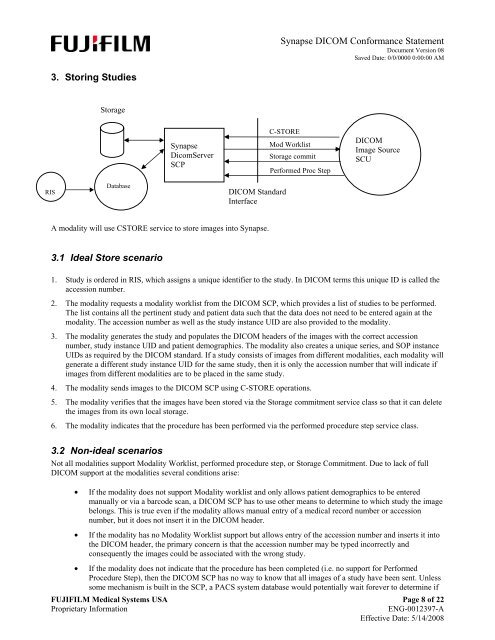DICOM Conformance Statement - Medical Systems
DICOM Conformance Statement - Medical Systems
DICOM Conformance Statement - Medical Systems
Create successful ePaper yourself
Turn your PDF publications into a flip-book with our unique Google optimized e-Paper software.
RIS<br />
3. Storing Studies<br />
Storage<br />
Database<br />
A modality will use CSTORE service to store images into Synapse.<br />
3.1 Ideal Store scenario<br />
Synapse <strong>DICOM</strong> <strong>Conformance</strong> <strong>Statement</strong><br />
Document Version 08<br />
Saved Date: 0/0/0000 0:00:00 AM<br />
1. Study is ordered in RIS, which assigns a unique identifier to the study. In <strong>DICOM</strong> terms this unique ID is called the<br />
accession number.<br />
2. The modality requests a modality worklist from the <strong>DICOM</strong> SCP, which provides a list of studies to be performed.<br />
The list contains all the pertinent study and patient data such that the data does not need to be entered again at the<br />
modality. The accession number as well as the study instance UID are also provided to the modality.<br />
3. The modality generates the study and populates the <strong>DICOM</strong> headers of the images with the correct accession<br />
number, study instance UID and patient demographics. The modality also creates a unique series, and SOP instance<br />
UIDs as required by the <strong>DICOM</strong> standard. If a study consists of images from different modalities, each modality will<br />
generate a different study instance UID for the same study, then it is only the accession number that will indicate if<br />
images from different modalities are to be placed in the same study.<br />
4. The modality sends images to the <strong>DICOM</strong> SCP using C-STORE operations.<br />
5. The modality verifies that the images have been stored via the Storage commitment service class so that it can delete<br />
the images from its own local storage.<br />
6. The modality indicates that the procedure has been performed via the performed procedure step service class.<br />
3.2 Non-ideal scenarios<br />
Synapse<br />
DicomServer<br />
SCP<br />
C-STORE<br />
<strong>DICOM</strong> Standard<br />
Interface<br />
Mod Worklist<br />
Storage commit<br />
Performed Proc Step<br />
<strong>DICOM</strong><br />
Image Source<br />
SCU<br />
Not all modalities support Modality Worklist, performed procedure step, or Storage Commitment. Due to lack of full<br />
<strong>DICOM</strong> support at the modalities several conditions arise:<br />
• If the modality does not support Modality worklist and only allows patient demographics to be entered<br />
manually or via a barcode scan, a <strong>DICOM</strong> SCP has to use other means to determine to which study the image<br />
belongs. This is true even if the modality allows manual entry of a medical record number or accession<br />
number, but it does not insert it in the <strong>DICOM</strong> header.<br />
• If the modality has no Modality Worklist support but allows entry of the accession number and inserts it into<br />
the <strong>DICOM</strong> header, the primary concern is that the accession number may be typed incorrectly and<br />
consequently the images could be associated with the wrong study.<br />
• If the modality does not indicate that the procedure has been completed (i.e. no support for Performed<br />
Procedure Step), then the <strong>DICOM</strong> SCP has no way to know that all images of a study have been sent. Unless<br />
some mechanism is built in the SCP, a PACS system database would potentially wait forever to determine if<br />
FUJIFILM <strong>Medical</strong> <strong>Systems</strong> USA Page 8 of 22<br />
Proprietary Information ENG-0012397-A<br />
Effective Date: 5/14/2008


